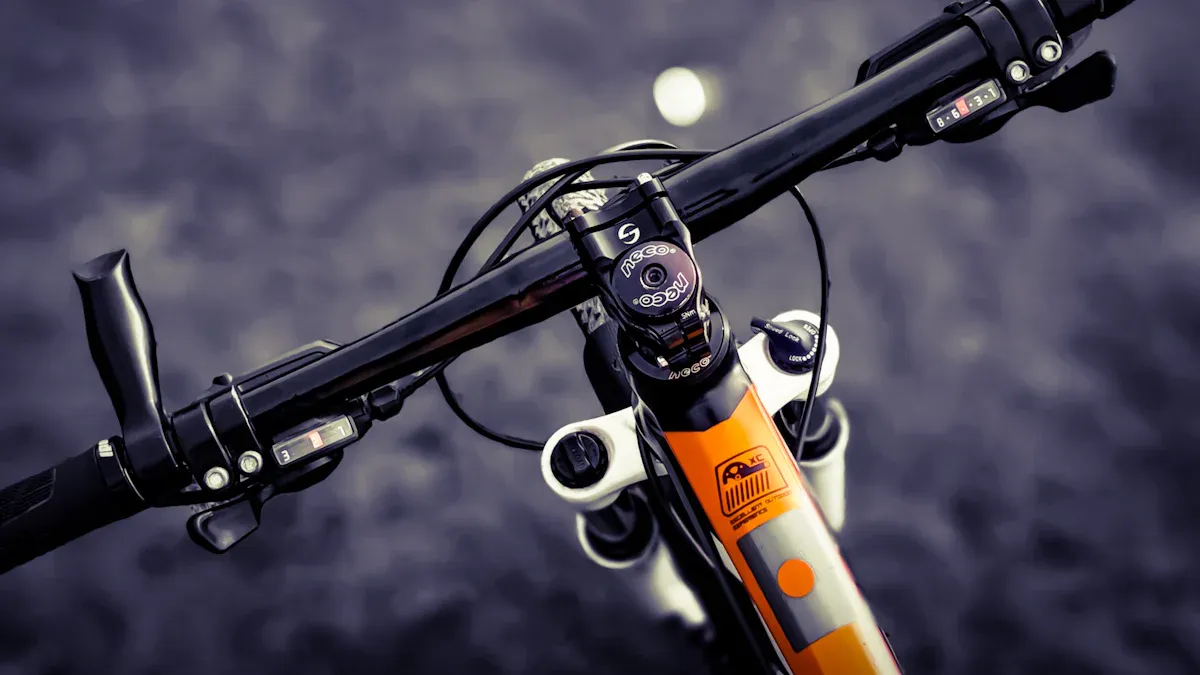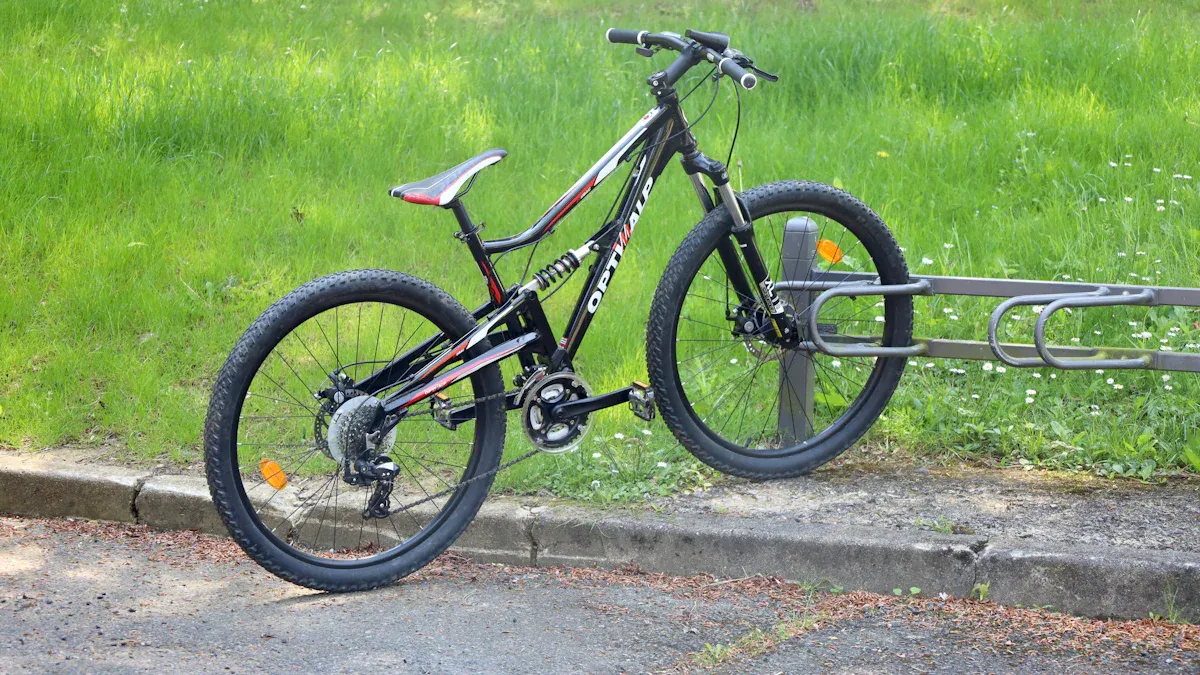
Choosing the right mountain bike frame and fork is very important. It affects how well you ride and how comfortable you feel on the trails. You need to think about a few things. These include your riding style, the kind of terrain you will ride on, and what the frame is made of. Here are some common things that riders consider:
Frame geometry (affects handling and comfort)
By knowing these things, you can make smart choices that fit your needs.
Key Takeaways
Pick the right frame type for your riding style. Use a hardtail for speed on smooth trails. A full suspension gives comfort on rough paths. A rigid frame helps with efficient pedaling.
Measure your height and inseam correctly. This helps you find the best frame size. A good fit makes riding more comfortable and gives you better control.
Think about the frame material. Aluminum is light and cheap. Carbon fiber is strong and light but expensive. Steel is durable and easy to fix.
Choose the right wheel size for what you need. A 26-inch wheel is good for agility. A 27.5-inch wheel offers balance. A 29-inch wheel gives stability and smooth rides.
Match your frame and fork to your riding style. This can improve your performance. Different setups work better for cross-country, trail, and downhill riding.
Frame Types for Mountain Bikes

When you choose a mountain bike frame, there are three main types: hardtail, full suspension, and rigid. Each type has its own pros and cons. They work better for different riding styles and terrains. Let’s look at each one.
Hardtail Frames
Hardtail frames are light and quick. They have front suspension but no rear suspension. This makes them great for cross-country (XC) trails and moderate terrain. Here are some important facts about hardtail frames:
Performance: Hardtails balance efficiency and comfort. They work well on smooth trails, helping you speed up and climb easier.
Comfort: They can handle rough terrain, but hardtails may not absorb shocks well. This can cause discomfort on bumpy trails since the rear tire bounces off obstacles.
Popularity: Hardtail frames are popular, making up about 62.1% of mountain bike sales. Many casual riders like them because they are affordable and fun.
Full Suspension Frames
Full suspension frames have both front and rear suspension. This gives you great control on tough terrain. They are perfect for technical trails and aggressive riding. Here’s what to know:
Performance: Full suspension bikes absorb shocks better, which makes rides more comfortable on rough trails. You can tackle obstacles with more confidence.
Comfort: These frames give a smoother ride, especially on long descents. However, they are usually heavier and need more maintenance.
Considerations: Full suspension bikes can cost more than hardtails. They might not be as fast on smooth terrain, which can slow you down on easier trails.
Type of Full Suspension | Advantages | Disadvantages |
|---|---|---|
Short Travel | Better shock absorption, improved traction on descents, more comfortable ride | Limited travel can feel unstable on rough terrain, may bottom out on larger jumps |
Long Travel | Great shock absorption, more stable on rough terrain | Heavier, less efficient, and more expensive than short travel |
Rigid Frames
Rigid frames are the simplest type. They have no suspension at all. They are good for efficient pedaling on mixed terrains but are less comfortable. Here’s more about them:
Performance: Rigid frames connect directly to the terrain. This can improve your control and responsiveness. They are light and quick, making them good for fast rides.
Comfort: Without suspension, you will feel every bump on the trail. This can be uncomfortable on rough surfaces, especially on longer rides.
Maintenance: Rigid frames usually need less maintenance than full suspension bikes. However, they may not handle tough trails as well.
Choosing the Right Mountain Bike Frame Size
Picking the right frame size for your mountain bike is very important. It helps with comfort and how well you ride. Measuring your height correctly can really change your riding experience. Here’s how to measure yourself right:
Measuring Your Height
To get the right frame size, you must measure your height correctly. Follow these steps:
Stand straight against a wall without shoes. This shows your true height.
For inseam measurement, stand with your back to the wall. Put a book between your legs and measure from the top of the book to the floor. This helps find standover height.
Use both height and inseam measurements to pick the best bike frame.
Tip: Always check these measurements with a mountain bike size chart or calculator to find the best fit.
Size Charts and Recommendations
Different brands have different size charts. So, it’s important to check them when choosing your mountain bike frame size. Here’s a quick look at some key measurements to think about:
Measurement | Description |
|---|---|
Reach | The distance from the bottom bracket to the head tube center. This affects rider position and control. |
Standover Height | The height of the top tube when you straddle the bike. This is important for getting on and off. |
Wheelbase | The distance between the front and rear axles. This affects stability and how easy it is to steer. |
Stack | The distance from the bottom bracket to the head tube. This affects handlebar height compared to the pedals. |
When it comes to frame sizes, here’s a general guide based on rider height:
Frame Size (cm) | Standard Frame Size | |
|---|---|---|
150 – 160 | 32 – 34 | XXS |
150 – 165 | 35 – 36 | XS |
155 – 170 | 37 – 39 | S |
165 – 175 | 40 – 41 | S |
170 – 180 | 42 – 44 | M |
175 – 185 | 45 – 46 | M |
180 – 190 | 47 – 49 | L |
184 – 193 | 50 – 52 | L |
187 – 196 | 53 – 54 | XL |
190 – 200 | 55 – 57 | XL |
195+ | 58 – 59 | XXL |
Note: Always think about your riding style when choosing a frame size. For example, aggressive riders may like longer frames for stability. Casual riders might want shorter frames for comfort.
Frame Materials and Their Benefits

The material of your mountain bike frame can really change your ride. Let’s look at the three most common materials: aluminum, carbon fiber, and steel.
Aluminum
Aluminum frames are popular for good reasons. They balance weight and strength well. Here are some important points:
Weight: Aluminum frames are light. This makes them great for climbing and fast rides. They weigh more than carbon fiber but less than steel.
Durability: Aluminum is strong, but it can get cracks over time. This happens more with heavy use.
Cost: You can find aluminum frames on most bikes under $3,500. They give good performance without costing too much.
Carbon Fiber
Carbon fiber frames are the top choice for serious riders. They have many benefits:
Weight: Carbon fiber frames are much lighter than aluminum. They can save you about 1.5 to 1.9 pounds. This helps with climbing and speeding up.
Durability: Carbon fiber is stronger than aluminum for its weight. It handles impacts better, so you worry less about damage.
Cost: Carbon fiber costs more. You usually find it on high-performance bikes because it is light and can be customized.
Steel
Steel frames have been used for a long time and are still popular. Here’s what to know:
Weight: Steel frames are usually heavier than aluminum and carbon fiber. But they give a smooth ride because they flex naturally.
Durability: Steel is very strong and can take a lot of wear. If you damage it, repairs are usually easy and cheap.
Cost: Steel frames can vary in price. They often give great value for those wanting durability without the high cost of carbon fiber.
Material | Weight Comparison | Durability Description | Cost Considerations |
|---|---|---|---|
Aluminum | Lightweight | Can develop cracks over time | Common for bikes under $3,500 |
Carbon Fiber | Very lightweight | Strong, handles impacts well, but hard to fix if damaged | High-end option, great for performance |
Steel | Heavier | Very durable, easy to repair | Good value, often cheaper than carbon |
Choosing the right material for your mountain bike frame can improve your performance and comfort on trails. Think about your riding style, budget, and how much maintenance you want to do.
Importance of Wheel Size in Mountain Bikes
When it comes to mountain biking, wheel size plays a big role in how your bike handles and how comfortable your ride feels. Different sizes can change your experience on the trails. Let’s break down the three main sizes: 26-inch, 27.5-inch, and 29-inch wheels.
26-inch Wheels
26-inch wheels were once the standard for mountain bikes. They offer some unique benefits:
Pros:
Quick acceleration and easy maneuverability.
Lightweight, making them great for climbing.
Lower center of gravity, which helps with stability.
Cons:
Struggle with larger obstacles like rocks and roots.
Less stable at high speeds.
Rarely seen on new bikes today.
27.5-inch Wheels
27.5-inch wheels are a happy medium between the smaller and larger sizes. They combine agility with stability:
Pros:
Improved roll-over ability and traction.
Faster top speed compared to 26-inch wheels.
Great for technical terrain, as they provide a snappy feel.
Cons:
Slightly heavier than 26-inch wheels.
Not as stable as 29-inch wheels on steep descents.
29-inch Wheels
29-inch wheels have gained popularity, especially for cross-country riding. They offer several advantages:
Pros:
Excellent traction and roll-over ability.
Smoother ride over rough terrain.
Better for long rides, as they maintain speed well.
Cons:
Heavier, which can make them cumbersome on tight trails.
May feel bulky for shorter riders.
Here’s a quick comparison of the wheel sizes:
Wheel Size | Advantages | Disadvantages |
|---|---|---|
26-inch | Quick acceleration, lightweight, agile | Struggles with bigger obstacles, less stable at high speeds |
27.5-inch | Combines agility and stability, good for technical terrain | Heavier than 26-inch, slightly less stable on steep descents |
29-inch | Superior roll-over ability, smoother ride | Heavier, harder to maneuver on tight trails |
Choosing the right wheel size can greatly impact your riding experience. Think about your riding style and the terrain you’ll tackle. Whether you prefer the quickness of 26-inch wheels, the balance of 27.5-inch wheels, or the stability of 29-inch wheels, each size has its place in the world of mountain biking.
Matching Frame and Fork to Riding Style
When you pick a mountain bike, it’s very important to match the frame and fork to your riding style. Different styles need special setups to help you ride better and feel comfortable on the trails. Let’s see how to choose a mountain bike frame and fork based on how you like to ride.
Cross-Country Riding
If you like cross-country (XC) riding, you need a setup that focuses on speed and efficiency. Look for a frame with a steeper head angle. This design helps you steer faster and climb better. Here are some important features to think about:
Fork Travel: Aim for a fork travel range of 80-100mm. This range is great for XC racing and light trail riding, helping you pedal efficiently.
Weight: A light frame helps you keep speed over long distances.
Versatility: Your bike should handle different terrains, from climbs to descents.
Fork Travel Range | Characteristics | Use Cases |
|---|---|---|
80-100mm | Cross-country racing, Light trail riding | Recommended for cross-country mountain biking |
120-140mm | Trail riding, All-around versatility | Suitable for versatile riding styles |
Trail Riding
For trail riding, you want a mix of stability and maneuverability. A slacker head angle gives you more stability at high speeds and helps with handling on descents. Here’s what to remember:
Frame Stiffness: Look for a frame that’s stiff sideways to stop energy loss while being a bit springy to absorb bumps.
Fork Trail: A longer fork trail makes steering more stable, which helps you ride hands-free on long rides.
Downhill Riding
If downhill riding is what you love, you’ll need a strong setup. A slack head angle and a longer travel fork are key for handling steep descents and rough terrain. Think about these features:
Fork Travel: Choose a fork travel of 180mm or more. This allows for the best impact absorption on jumps and drops.
Frame Material: A full-suspension mountain bike is perfect for downhill riding, giving you the support and comfort you need.
Riding Discipline | |
|---|---|
Cross-Country (XC) | 100mm – 120mm |
Trail | 130mm – 150mm |
Downhill (DH) | 180mm – 200mm+ |
By knowing these features, you can make smart choices about your mountain bike frame and fork. This understanding helps you avoid mismatched setups and makes sure you enjoy your rides to the fullest.
Picking the right frame and fork for your mountain bike is very important for how you ride. Here are some important points to remember:
Frame Features: Look for features like frame guards and hidden cables for strength.
Suspension Travel & Design: Pick the right suspension travel for your trails to stay efficient.
Geometry: Know how frame shape affects balance and control.
Frame Size & Fit: Make sure the bike fits your body and riding style for the best comfort.
Take your time to think about what you like and how you ride. Don’t be afraid to ask for help or try different bikes. This way, you’ll find the best setup for you! Happy riding! 🚴♂️
FAQ
What frame size should I choose for my height?
To find the right frame size, measure your height and inseam. Use a size chart from the bike brand to match your measurements. A good fit helps you feel comfortable and have better control while riding.
How do I know if I need a hardtail or full suspension bike?
Pick a hardtail for smooth trails and easy climbing. Choose full suspension if you ride on rough terrain or want comfort on downhill rides. Your riding style and the terrain will help you decide.
What’s the difference between aluminum and carbon fiber frames?
Aluminum frames are light and cheap, making them good for casual riders. Carbon fiber frames are lighter and stronger but cost more. Choose based on how much you can spend and what you need for performance.
How does wheel size affect my ride?
Wheel size changes how your bike handles and how comfortable it feels. Smaller wheels (26-inch) are quick and easy to turn, while larger wheels (29-inch) are stable and roll over obstacles better. Think about your riding style and the terrain when picking wheel size.
How often should I maintain my mountain bike?
Regular maintenance keeps your bike working well. Check tire pressure, brakes, and gears before each ride. Do a full check every few months, including cleaning and oiling the chain and checking the suspension parts.
See Also
Selecting the Perfect Bike Frame Tailored to Your Requirements
Key Factors to Evaluate When Picking an E-Mountain Bike Frame
Professional Tips for Selecting the Ideal Carbon Mountain Bike Frame
Understanding the Differences Between Hardtail and Full Suspension Frames
